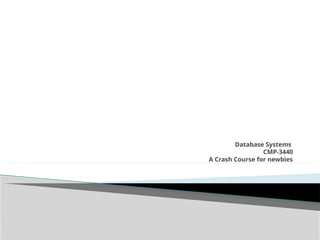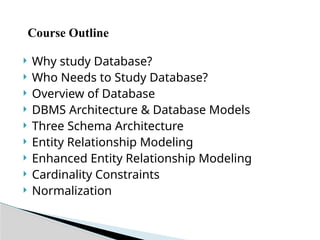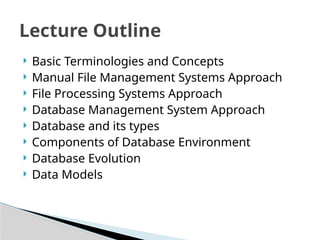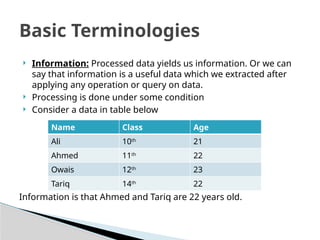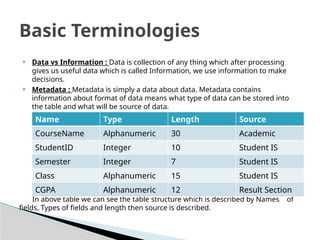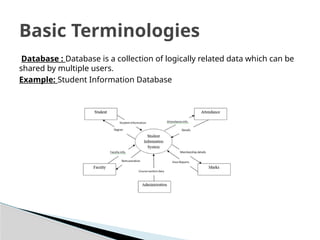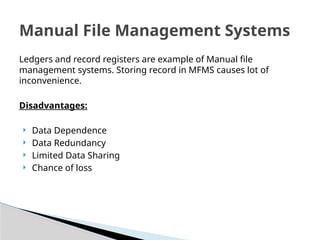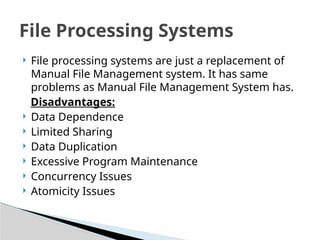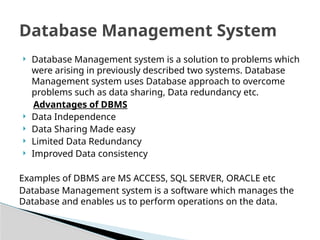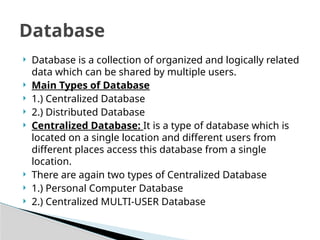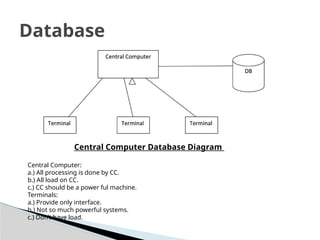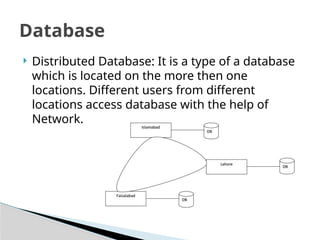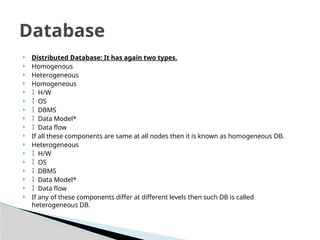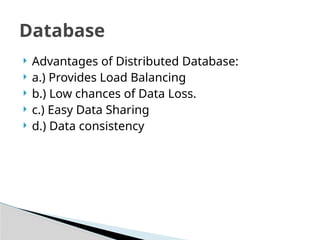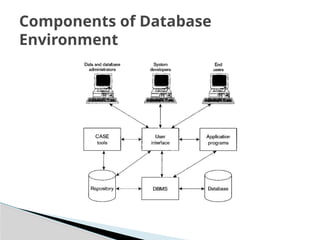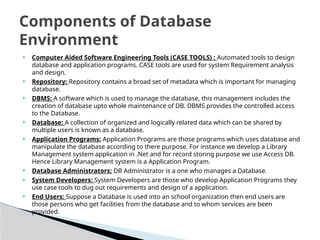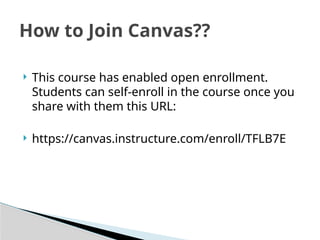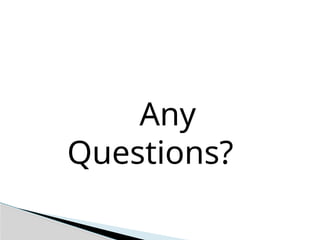1588332331-lecture-1-database-systems-overview.pptx
- 1. Database Systems CMP-3440 A Crash Course for newbies
- 2. ? Why study Database? ? Who Needs to Study Database? ? Overview of Database ? DBMS Architecture & Database Models ? Three Schema Architecture ? Entity Relationship Modeling ? Enhanced Entity Relationship Modeling ? Cardinality Constraints ? Normalization Course Outline
- 3. ? Basic Terminologies and Concepts ? Manual File Management Systems Approach ? File Processing Systems Approach ? Database Management System Approach ? Database and its types ? Components of Database Environment ? Database Evolution ? Data Models Lecture Outline
- 5. ? Data: Data is a collection of any thing it can be collection of names of students of class, contacts of person in contact book, DVDs collection names etc. Data is basically a facts and figures. ? Why we need data ?? Data is as important as any other asset is valuable. Data is important in lawful decision making. Example of data in Table is below. Basic Terminologies
- 6. ? Information: Processed data yields us information. Or we can say that information is a useful data which we extracted after applying any operation or query on data. ? Processing is done under some condition ? Consider a data in table below Information is that Ahmed and Tariq are 22 years old. Basic Terminologies Name Class Age Ali 10th 21 Ahmed 11th 22 Owais 12th 23 Tariq 14th 22
- 7. ? Data vs Information : Data is collection of any thing which after processing gives us useful data which is called Information, we use information to make decisions. ? Metadata : Metadata is simply a data about data. Metadata contains information about format of data means what type of data can be stored into the table and what will be source of data. In above table we can see the table structure which is described by Names of fields, Types of fields and length then source is described. Basic Terminologies Name Type Length Source CourseName Alphanumeric 30 Academic StudentID Integer 10 Student IS Semester Integer 7 Student IS Class Alphanumeric 15 Student IS CGPA Alphanumeric 12 Result Section
- 8. Database : Database is a collection of logically related data which can be shared by multiple users. Example: Student Information Database Basic Terminologies
- 9. Ledgers and record registers are example of Manual file management systems. Storing record in MFMS causes lot of inconvenience. Disadvantages: ? Data Dependence ? Data Redundancy ? Limited Data Sharing ? Chance of loss Manual File Management Systems
- 10. ? File processing systems are just a replacement of Manual File Management system. It has same problems as Manual File Management System has. Disadvantages: ? Data Dependence ? Limited Sharing ? Data Duplication ? Excessive Program Maintenance ? Concurrency Issues ? Atomicity Issues File Processing Systems
- 11. ? Database Management system is a solution to problems which were arising in previously described two systems. Database Management system uses Database approach to overcome problems such as data sharing, Data redundancy etc. Advantages of DBMS ? Data Independence ? Data Sharing Made easy ? Limited Data Redundancy ? Improved Data consistency Examples of DBMS are MS ACCESS, SQL SERVER, ORACLE etc Database Management system is a software which manages the Database and enables us to perform operations on the data. Database Management System
- 12. ? Database is a collection of organized and logically related data which can be shared by multiple users. ? Main Types of Database ? 1.) Centralized Database ? 2.) Distributed Database ? Centralized Database: It is a type of database which is located on a single location and different users from different places access this database from a single location. ? There are again two types of Centralized Database ? 1.) Personal Computer Database ? 2.) Centralized MULTI-USER Database Database
- 13. ? Personal Computer Database: It is a type of database which is installed on only one computer for example a shopkeeper inventory system on shop uses a personal computer database. ? It is a low scope database , because it is dedicated to only one system. ? Central Computer Database: Central computer database is a type in which there is a central computer (server) on which database is installed and other systems which are called (client/dumb terminals) are connected with this Central computer by any network. ? Database
- 14. Database Central Computer Database Diagram Central Computer: a.) All processing is done by CC. b.) All load on CC. c.) CC should be a power ful machine. Terminals: a.) Provide only interface. b.) Not so much powerful systems. c.) Doní»t have load.
- 15. ? Distributed Database: It is a type of a database which is located on the more then one locations. Different users from different locations access database with the help of Network. Database
- 16. ? Distributed Database: It has again two types. ? Homogenous ? Heterogeneous ? Homogeneous ? ? H/W ? ? OS ? ? DBMS ? ? Data Model* ? ? Data flow ? If all these components are same at all nodes then it is known as homogeneous DB. ? Heterogeneous ? ? H/W ? ? OS ? ? DBMS ? ? Data Model* ? ? Data flow ? If any of these components differ at different levels then such DB is called heterogeneous DB. Database
- 17. ? Advantages of Distributed Database: ? a.) Provides Load Balancing ? b.) Low chances of Data Loss. ? c.) Easy Data Sharing ? d.) Data consistency Database
- 18. ? Components of database environment describes those components which are involved with database could me DB Administrators, System Developers or End users. They are mostly nine in number. Detail of them are given below. Main Components ? Data and Database System Administrators ? System Developers ? End Users ? CASE Tools ? User Interface ? Application Programs ? Repository ? DBMS ? Database Components of Database Environment
- 20. ? Computer Aided Software Engineering Tools (CASE TOOLS) : Automated tools to design database and application programs. CASE tools are used for system Requirement analysis and design. ? Repository: Repository contains a broad set of metadata which is important for managing database. ? DBMS: A software which is used to manage the database, this management includes the creation of database upto whole maintenance of DB. DBMS provides the controlled access to the Database. ? Database: A collection of organized and logically related data which can be shared by multiple users is known as a database. ? Application Programs: Application Programs are those programs which uses database and manipulate the database according to there purpose. For instance we develop a Library Management system application in .Net and for record storing purpose we use Access DB. Hence Library Management system is a Application Program. ? Database Administrators: DB Administrator is a one who manages a Database. ? System Developers: System Developers are those who develop Application Programs they use case tools to dug out requirements and design of a application. ? End Users: Suppose a Database is used into an school organization then end users are those persons who get facilities from the database and to whom services are been provided. Components of Database Environment
- 21. ? Data model is first step in Database design process which describe the logical structure of database. It tells us how data is connected to each other and how is stored, Processed. It describes what type of relations will be between data. ? ER Data Model ? Object oriented Data Model ? Network Data Model ? Hierarchical Data Model Data Models
- 22. ? 1.1 List four significant differences between a file- processing system and a DBMS. ? 1.2 This chapter has described several major advantages of a database system. What are two disadvantages? Due Date and Other Details are given on Canvas. Home Work
- 23. ? This course has enabled open enrollment. Students can self-enroll in the course once you share with them this URL: ? https://canvas.instructure.com/enroll/TFLB7E How to Join Canvas??
- 24. Any Questions?
